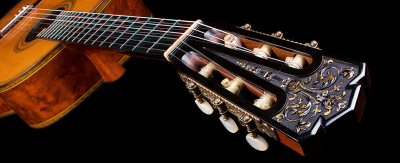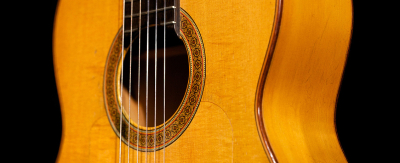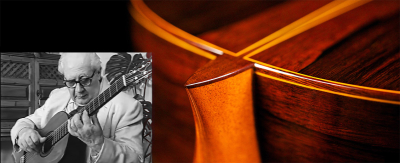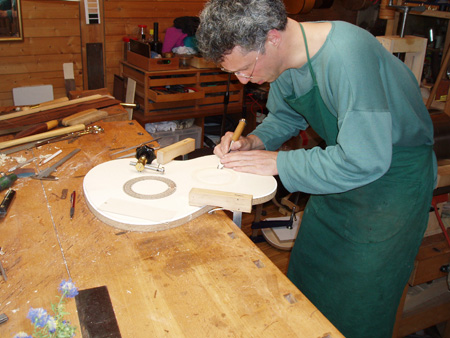A Plea For Traditional Construction
I thought we’d follow up last week’s post of Marcelo Kayath’s article on the current state of guitars with this piece by luthier Sebastian Stenzel titled “From a Guitar Maker’s Notes: A Plea For The Traditional Construction of Classical Guitar Soundboards”. Stenzel has an affinity for physics, and he seems to come at this from as much a scientific point of view as an aesthetic one.
FROM A GUITAR MAKER’S NOTES: A PLEA FOR THE TRADITIONAL CONSTRUCTION OF CLASSICAL GUITAR SOUNDBOARDS
by Sebastian Stenzel, Guitar maker
Again and again I have been asked for my opinion of modern classical guitars with “double top,” lattice bracing, carbon-balsa-laminated soundboards and similar features of construction. While it is everybody’s good right to see these guitars as an improvement, I do not. This is why.
For those not familiar with this relatively new type of classical guitar, I will explain the underlying concept of construction. The aim is, simply put, to make a louder guitar. As the input of energy into the string is limited, the output of sound can only be increased by increasing the efficiency of the instrument. This is done by two means: First, by reducing all sources of energy loss, i.e. when energy is used up but does not contribute to the sound radiation from the soundboard. Second, by maximizing the ratio of sound velocity to the mass of the soundboard (which correlates more or less directly with stiffness to mass) and by reducing the internal damping of the soundboard (mainly internal friction). The first is done for example with “double sides,” which are simply two sides glued together. This typically yields a very heavy and stiff side with a thickness of 4 mm and is usually, but not always, coupled by an extremely massive back. (These double sides were, to the best of my knowledge, first introduced by Daniel Friedrich, but he never used thick backs.) Back and sides this thick will not vibrate much, and therefore very little energy from the string will be “wasted” in these parts.
The maximization of the stiffness-to-mass-ratio is achieved by constructing a lighter but stiffer soundboard. One possibility, for example, is gluing a sandwich of two very thin cedar soundboards back and front onto a very light and stiff synthetic honeycomb-structure made from aramid fibers, or by laminating carbon fibre with balsa wood (the lightest wood there is) and/or by using struts laminated in the same way, or by any combination of similar methods. The result is a louder guitar.
So what’s wrong with this new approach to guitar construction? Nothing is wrong. I just heard one of these guitars in concert the other day. It was really loud, and I got headache and bellyache, and just hoped the concert would be over soon. I really suffered physically from the sound of the guitar, but said to myself that this is an example of déformation professionnell. But to my surprise, I found I wasn’t alone: after the concert I heard several people, who I knew were not guitarists, relate the same symptoms. Later, three guitarists, who had been among the audience, too, confessed that they had not liked the concert at all, but would have never dared to say so openly, because the artist is a highly respected player in the guitar community. There were many more guitarists present at this concert. What will be their honest opinion? But I don’t want to start a discussion about the genesis of “mainstream” here, but rather get on with a more scientific criticism.
Along with an increase of efficiency comes almost unavoidably an increase of admittance of the soundboard. That means energy from the string is transferred faster to the soundboard. The admittance depends on frequency and even if the resonance frequencies of the soundboard are well placed, the balance of the guitar will suffer dramatically just from this effect. Wolf notes and “holes” (see footnote 1) become much more audible, but even more severe is a tendency to general overcoupling. Overcoupling means that the string is not telling the soundboard what to do, but rather the other way round, as it were. This causes a distortion of notes or of partials of notes. Such notes sound somewhat queer to the listener, but it takes a very trained ear to distinguish the precise nature of the distortion. Often, it is only one inharmonious partial note, but with a surprisingly high sound level. In extreme cases, overcoupling is enough to render a guitar impossible to tune, especially when it is one of other sources of faulty intonation (see footnote 2).
A high average admittance is what the player calls a fast attack of the guitar. Explosive or percussive sound are other common equivalents, and I want to emphasize that these elements of sound are vital for the guitar to be a guitar. “Percussive” means containing a lot of noise, i.e. non-harmonic or chaotic oscillation. High admittance also means that due to the very low impedance of the air, there is a strongly increased radiation damping (loss of energy in the string/soundboard through radiation of sound). In other words, the energy is fired off quickly and the additional power is mainly showing in the first milliseconds of a note, amplifying also all the side noises caused by the initial touch of the string by either hand. So although there is more energy available from such soundboards, the sustain is usually not longer than that of traditional guitars, but the relatively faster decrease of the sound level is well heard. All in all, a percussive sound with a high peak level at the beginning of the note is produced.
(I cannot resist to open a paragraph here to add a thought about the development of plucked instruments as such: I consider the classical guitar the queen of the family of plucked instruments, because it attempts, so to speak, to rise beyond its nature of having a plucked and therefore limited, more or less percussive tone, aiming at a long, sustained one. The lute, for example, is not in the least ashamed of its more percussive sound, reminiscent of the goat skin of its ancestors. It is the electric guitar, which finally succeeded in this respect, but that’s not cricket, boys. Be that as it may, the balance of percussive and “clean” elements of sound are especially important in the design of sound of the guitar in comparison to other instruments.)
Of course some makers working in this new style are perfectly aware of the problems described above. They will give additional stiffness to the soundboard, to get the overcoupling under control. So far, so good, but they cannot change the impedance (the opposite of admittance) of the air, the next vehicle for the sound on its way to our ear. For this reason alone, a guitar with a higher efficiency in sound radiation, will inevitably have a very different sound characteristic. Only time will tell if this will be generally accepted as the typical guitar sound. Personally, I doubt it.
The most important point I would like to make, and maybe the most misunderstood of all, concerns the loudness of the guitar. First of all, loudness or volume is not something you can physically measure, but rather a psychoacoustic phenomenon. A tone that sounds loud to the player is not necessarily loud to the audience. Vice versa, a guitar of apparently little volume, e.g. an old Hauser, may exhibit surprising projection. So loudness and projection, the ability to carry far, are two different things. There are mainly three reasons for this: The first is that the direction of sound distribution depends on frequency: low frequencies are distributed more or less in all directions evenly, that is spherical around the player. The higher the frequencies are, the more directional, focused, the distribution is in a perpendicular direction from the soundboard (whoever has sat sideways of the player at a guitar concert knows what I am talking about.) That means that the decrease with distance in sound intensity is much higher in the bass.
The second reason is that the loudness we hear is the result of a complex calculation performed by our brain on the basis of the various levels of excitement in separate nerves connecting the basilar membrane of the inner ear, each in charge of its own frequency group. But unless we make a conscious effort (and have a trained ear) we hear only one loudness attributed to one note: the average loudness of all partial notes.
The third reason is that the human ear has its highest sensitivity in the range around 2.5 kHz. In this frequency range, we will still hear even very week partials of notes to which our miraculous brain is capable of adding the missing partials, even the fundamental frequency. But this sensitivity decreases dramatically with frequency: for the fundamentals of the low E- string for example, it is approximately 20 times less.
For these reasons, a guitar carries well, when it has a high average sound level in the range of the lower overtones, especially between 2 and 4 kHz. These frequencies are high enough to be projected fairly focused, and they meet the highest sensitivity of the ear. Lower partials that get lost on the way because they are too busy showing off to all the nice ladies in the first row, can be substituted by the brain, but of course only to a certain extent.
As it is, the achieved increase of efficiency of the guitars in question is found almost exclusively in the bass range and not in the range between 2 and 4 kHz. As a result, there is no improved projection.
The big difference in sound intensity between the initial peak and the following steep decrease has still other negative effects: typical is a poverty in sound colours, variation of timbre, and a general lack of modulation capacity (I have phrased this term to describe the ease with which sound properties can be varied by the player.) This deficiency occurs, because most of the energy is used up before the player even begins to initiate , for example, a vibrato. In addition, the ear of the listener is, so to speak, calibrated on forte, while the vibrato is then happening in the part of the note which is rather piano. The poverty in sound colours has similar reasons: most of the energy goes to the percussive section of the note, and the higher overtones do not have enough energy and/or sustain to really play with.
If the reader finds my arguments convincing, one has to wonder why guitars of the type described above have become more and more popular. In an attempt to avoid the old theme of art versus mainstream, I still would like to elucidate two points which may help to understand why this is so. The first and very obvious is that the low volume is limiting the use of the guitar in chamber or orchestral music, which has caused some kind of collective inferiority complex among guitarist, making many very susceptible for any promise of redemption from this Achilles’ heel. The second point, as strange as it my sound, is that a truly great guitar is a very rare thing. I believe that even many professional players never came across one. And if I had to choose between two guitars of average (high) quality, I would of course take the louder one, too. Still another aspect is that many of these guitars are bought, because a famous guitarist is playing one in concert, assuming the instrument was chosen for its sound properties. But a guitarist touring the world and playing in front of large audiences often has quite different priorities than the average player, such as reliability regarding different acoustical surroundings, extreme climatic conditions, or sensitivity to transportation in an aircraft.
So far, I have spoken only about sound properties, but there are other aspects, too. The longevity of the modern constructions is not known, and the prognosis is not good at all: it can be assumed that a “double top” or laminated soundboard will last only as long as the glue, usually epoxy resin or polyurethan, which keeps it together. Far from any scientific research, the deformation of my carbon fibre/epoxy windsurfing mast when left under tension tells me enough to stick with hide glue, which has proofed its durability for centuries.
What actually determines the life span of guitar? The vast number of old violins shows that the aging process of the wood is not what is setting the limit. I believe that in addition to the physical properties of the specific piece of wood used and the construction and thickness of the soundboard (see footnote3) there are two major sources of strain, causing material fatigue which finally weakens the soundboard so much that the guitar cannot carry the strings any more. One is string tension and the vibrations when the guitar is played, the other is the tension build up with changes of the relative humidity of the air. In the “double top” or laminated soundboards, the wood cannot react to the tension build up by changes in the relative humidity of the air by swelling or shrinking, so the full tension goes to the cell-structure of the wood. The sound quality decreases usually a long time before it becomes too weak to carry the strings. This process happens faster or slower, depending on many things, but cedar (thuja plicata), usually preferred by the makers of these guitars, is known to last not as long as spruce and for a tendency to show sudden “acoustical death.” It has to be noted, that cedar was not used for guitar soundboard before 1964, so we still cannot say anything about how long a guitar with cedar soundboard could last, but unfortunately example of decrepit cedar guitars are already abundant.
The guitar is considered by some as a still young instrument, and certainly it is developing much more than the violin for example. Although I would not agree with the common opinion that there have been no new achievements since the early 20th century for the classical guitar, I do not think it is very far from the truth, either. History shows that the development of musical instruments is happening rather in leaps than as a continuous process. Certainly Antonio de Torres represents such a leap. But his guitars opened new musical possibilities to the players and new possibilities of reaching the heart of the listener. I doubt that this can be said for the new style of guitar discussed here.
Of course, one can maintain that my arguments against constructions which aim at maximization of sound radiation are mere generalizations. This is true and I apologise to any colleague who, like all of us, is just striving to make a better guitar and who feels I have done injustice to his work. The classical guitar is one of the most complex musical instruments, making general judgements on single components rather meaningless. There are, no doubt, excellent guitars built with the methods I have questioned here, examples of the skilful art of their makers to compensate for the deficiencies these constructions are prone to. I hope that my criticism is considered well-founded and taken as a contribution to help make more of these rare, truly great guitars, no matter how they are constructed.
Footnotes:
1 – Both imply a too strong resonance, but when there is a “hole,” it simply means that the energy “sucked out” of the string is not used up in effective sound radiation. This is the case e.g. by a bipolar mode of the soundboard where one side is “pumping” air, while the other is “sucking”, thus neutralizing the effect of sound radiation.
2 – This does not refer only to badly set frets or wrong compensation at the bridge. Almost all guitars have an inbuilt deviation of pitch in the area around the 6th fret and in the highest frets. This is described in detail in my article “Intonation and playability”, first published in “Gitarre und Laute”, 1995.
3 – The thickness relates to stability, the moment of inertia of the cross section, to be precise, to the third power. Beware of very thin soundboards from the hands of inexperienced guitar makers!
70 comments








